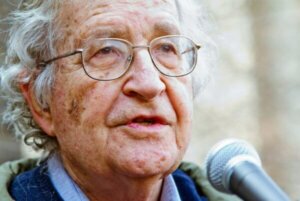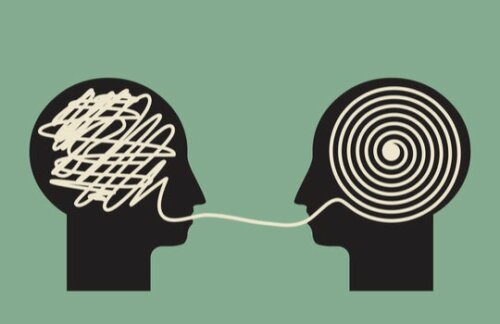The Linguistic Theory of Noam Chomsky

Noam Chomsky’s linguistic theory is one of the most important regarding human language. The world knows it as either generative grammar or biolinguistics. It demonstrates that an innate mental structure makes it possible to understand and produce any utterance in any natural human language. Furthermore, it makes it possible for the process of acquiring and mastering language to require little processing in the brain to get going. Also, it develops almost automatically.
Noam Chomsky’s linguistics theory is controversial despite its importance. Thus, many scholars don’t believe it’s a good explanation of language acquisition and language functioning. This criticism is due to two factors. The first might be the way in which Chomsky explains the emergence of concepts in the mind. Moreover, the second is that Chomsky believes that certain syntactic principles are universal. Known in all languages, that is.
“Language is a process of free creation; its laws and principles are fixed, but the manner in which the principles of generation are used is free and infinitely varied. Even the interpretation and use of words involves a process of free creation.”
-Noam Chomsky-
General characteristics of Noam Chomsky’s linguistic theory
Chomsky’s first distinction in generative grammar is that between linguistic competence and performance. According to the author, competence corresponds to the capacity of an ideal speaker-listener to associate sounds and meanings according to unconscious automatic rules.
Furthermore, linguistic performance refers to the interpretation and comprehension of sentences in accordance with competence but also regulated by extra-linguistic principles. Memory constraints or beliefs, for example.
A significant part of generative grammar is mostly aimed at ideal speaker-listeners. In other words, people who supposedly know the language perfectly and who never make mistakes. This is because they aren’t affected by distractions or context constraints.
Thus, it seems that Chomsky’s linguistic theory is mainly a theory of competence, not of performance. This is because it doesn’t account for the production or perception of language in everyday circumstances. Chomsky’s linguistic theory explains language in abstract, ideal states, translatable with difficulty into the way language is currently used.

First generative grammar in linguistic theory
In his book Syntactic Structures, Chomsky proposes the existence of a mental device. One by which any sentence of any natural language can happen by connecting meanings and sounds. This is the language acquisition device and it has three components: syntactic, semantic, and phonological.
Syntactic component
This component has a base and a transformational component.
- Firstly, the composition of the base is a categorial component and a lexicon. According to generative grammar, lexical entries correspond strictly to arrays of semantic, syntactic, and phonological features. One can associate them with different words in different languages. Thus, the lexicon would consist of concepts rather than terms and these would exist before their associations with other words. In contrast, the categorial component consists of a set of rules that allow rewriting phrases or sets of phrases to make derivations from them. These rules are known as transformational rules and belong to transformational grammar, considered insufficient by this author as a global grammatical theory. However, it’s definitely adequate to explain part of the acquisition and functioning of language.
- Secondly, the transformational component carries out the transformational rules. These involve changes in the structure of the strings that have already been generated by means of generational rules.
Semantic component
The semantic component consists of a non-specific set of semantic rules that assign meanings to the deep structure. The goal is to convert a deep structure into a meaningful representation.

The phonological component of the linguistic theory
This component forms by a set of morphophonemic rules that govern the conversion of morphemes into phonemes. Thus, to sum it up, they regulate the pronunciation of words and utterances.
Furthermore, Chomsky’s linguistic theory states that all the rules that allow the comprehension and production of language are logical and unconscious. These rules would determine, for example, that people should pronounce “ig” as [ay] in English when it precedes a nasal word ending, as in the case of sign [sayn].
Chomsky proposed his theory to explain how people acquire, understand, and produce spoken language. This theory postulates that all human beings acquire maternal speech automatically. The lack of realism of this theory is what people criticize the most, which is why it’s controversial.
Noam Chomsky’s linguistic theory is one of the most important regarding human language. The world knows it as either generative grammar or biolinguistics. It demonstrates that an innate mental structure makes it possible to understand and produce any utterance in any natural human language. Furthermore, it makes it possible for the process of acquiring and mastering language to require little processing in the brain to get going. Also, it develops almost automatically.
Noam Chomsky’s linguistics theory is controversial despite its importance. Thus, many scholars don’t believe it’s a good explanation of language acquisition and language functioning. This criticism is due to two factors. The first might be the way in which Chomsky explains the emergence of concepts in the mind. Moreover, the second is that Chomsky believes that certain syntactic principles are universal. Known in all languages, that is.
“Language is a process of free creation; its laws and principles are fixed, but the manner in which the principles of generation are used is free and infinitely varied. Even the interpretation and use of words involves a process of free creation.”
-Noam Chomsky-
General characteristics of Noam Chomsky’s linguistic theory
Chomsky’s first distinction in generative grammar is that between linguistic competence and performance. According to the author, competence corresponds to the capacity of an ideal speaker-listener to associate sounds and meanings according to unconscious automatic rules.
Furthermore, linguistic performance refers to the interpretation and comprehension of sentences in accordance with competence but also regulated by extra-linguistic principles. Memory constraints or beliefs, for example.
A significant part of generative grammar is mostly aimed at ideal speaker-listeners. In other words, people who supposedly know the language perfectly and who never make mistakes. This is because they aren’t affected by distractions or context constraints.
Thus, it seems that Chomsky’s linguistic theory is mainly a theory of competence, not of performance. This is because it doesn’t account for the production or perception of language in everyday circumstances. Chomsky’s linguistic theory explains language in abstract, ideal states, translatable with difficulty into the way language is currently used.

First generative grammar in linguistic theory
In his book Syntactic Structures, Chomsky proposes the existence of a mental device. One by which any sentence of any natural language can happen by connecting meanings and sounds. This is the language acquisition device and it has three components: syntactic, semantic, and phonological.
Syntactic component
This component has a base and a transformational component.
- Firstly, the composition of the base is a categorial component and a lexicon. According to generative grammar, lexical entries correspond strictly to arrays of semantic, syntactic, and phonological features. One can associate them with different words in different languages. Thus, the lexicon would consist of concepts rather than terms and these would exist before their associations with other words. In contrast, the categorial component consists of a set of rules that allow rewriting phrases or sets of phrases to make derivations from them. These rules are known as transformational rules and belong to transformational grammar, considered insufficient by this author as a global grammatical theory. However, it’s definitely adequate to explain part of the acquisition and functioning of language.
- Secondly, the transformational component carries out the transformational rules. These involve changes in the structure of the strings that have already been generated by means of generational rules.
Semantic component
The semantic component consists of a non-specific set of semantic rules that assign meanings to the deep structure. The goal is to convert a deep structure into a meaningful representation.

The phonological component of the linguistic theory
This component forms by a set of morphophonemic rules that govern the conversion of morphemes into phonemes. Thus, to sum it up, they regulate the pronunciation of words and utterances.
Furthermore, Chomsky’s linguistic theory states that all the rules that allow the comprehension and production of language are logical and unconscious. These rules would determine, for example, that people should pronounce “ig” as [ay] in English when it precedes a nasal word ending, as in the case of sign [sayn].
Chomsky proposed his theory to explain how people acquire, understand, and produce spoken language. This theory postulates that all human beings acquire maternal speech automatically. The lack of realism of this theory is what people criticize the most, which is why it’s controversial.
All cited sources were thoroughly reviewed by our team to ensure their quality, reliability, currency, and validity. The bibliography of this article was considered reliable and of academic or scientific accuracy.
-
Berwick, R. C., & Chomsky, N. (2011). The Biolinguistic Program: The Current State of its Evolution and Development. Biolinguistic Investigations, ed. by A.-M. DI SCIULLO & C. AGUERO.
-
Birchenall, L. B., & Müller, O. (2014). La teoría lingüística de Noam Chomsky: del inicio a la actualidad. Lenguaje, 42(2), 417-442.
-
Chomsky, N. (1975). Aspectos de la teoría de la sintaxis (No. 415 C4Y).
-
Hierro, J. (1976). La teoría de las ideas innatas en Chomsky. Labor, Barcelona.
-
Chomsky, N. (1956). Three models for the description of language. IRE Transactions on information theory, 2(3), 113-124.
This text is provided for informational purposes only and does not replace consultation with a professional. If in doubt, consult your specialist.







